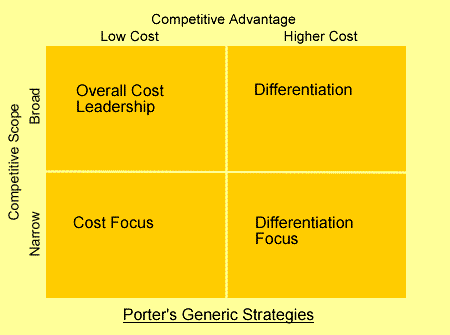Business Level Strategy Formulation
Business-Level Strategies
Introduction
- Business-level strategies refer to individual strategies that are practiced by organizations for each of their business units separately.
- In a large organization, each of its business unit is termed as a Strategic Business Unit (SBU). Every SBU has its own unique strategy.
- The focus of business-level strategies is on decisions regarding a particular product or service of an SBU.
- Organizations practice business-level strategies to support the corporate-level strategies.
- Business-level strategies of an organization should be directed towards making the organization financially viable more and efficient as compared to its competitors.
- Business level strategies are detail actions taken to provide value to customers and gain a competitive advantage by exploiting core competencies in specific, individual product or service markets.
- Business-level strategy is concerned with a firm’s position in an industry, relative to competitors and to the five forces of competition.
Main areas of concern for business-level strategies
The main areas of concern for business-level strategies are as follows:
- Managing and integrating the activities of the business unit with the corporate-level strategies
- Building the distinctive competencies and competitive advantages of each business, unit
- Identifying the markets for products or services and developing strategies for the same with the coordination of corporate-level strategies
- Examining and evaluating the strategies according to the needs of market
Michael porter’s generic business strategies
Michael Porter has called business-level strategies as generic business strategies. Porter defined each generic strategy with the help of two dimensions, which are as follows:
- Competitive Advantage: Implies the supply-side dimension that focuses on the competitiveness and strength of the organization
- Competitive Scope: Refers to a demand-side dimension that focuses on the size and composition of the target market.

1.Cost Leadership:
- Refers to a strategy in which an organization produces products at the lowest cost.
- An organization can gain competitive advantage as a cost leader in the market by producing standardized products in high volumes. This helps the organization to gain economies of scale or efficiency.
- An organization needs to continuously search for low cost factors of production to achieve and maintain this strategy.
- The sole aim of cost leadership strategy is cost reduction in the production of basic products for a wide range of customers.
2. Differentiation:
- Refers to a strategy in which an organization offers differentiated products in the market to attain competitive advantage.
- Unlike the cost leadership strategy, where the focus is on cost control, this strategy completely focuses on giving customized products to its customers to satisfy their needs.
- Differentiation strategy allows organizations to focus on value creation of the product, which in turn allows them to charge premium prices.
- Value is provided to customers through unique features and characteristics of an organization’s products rather than by the lowest price.
- This is done through high quality, features, high customer service, rapid product innovation, advanced technological features, image management, etc. (Some companies that follow this strategy: Rolex, Intel, Ralph Lauren)
- In addition, the organization is required to segment the target market in such a way that it targets the products and services in a profitable manner.
- Market segmentation can be done by differentiation of products in terms of design, brand image, technology, features, dealers, network, or customer’s service.
Focus Strategy:
Focus Strategy: Concentrates on selecting a specific customer segment with a view to cater to its specific needs by customizing the marketing mix and product mix. Markets entailing very specific customer segments are called niche markets.
The focus strategy is suitable for the smaller organizations that neither have cost leadership nor differentiation strategy. It allows organizations to streamline their efforts and resources on a narrow and specifically defined segment of a market. Every market segment or niche has its own competitive advantage.
Organizations can use the two variants of focus strategy, namely:
-
Focused Low Cost leadership–
Opts for the strategy that focuses on cost reduction. Focused cost strategy is adopted by organizations that sell products at low cost in small markets.
Organizations not only compete on price, but also select a small segment of the market to provide goods and services to. For example a company that sells only to the U.S. government.
-
Focused Differentiation–
Organizations not only compete based on differientation, but also select a small segment of the market to provide goods and services.
Focused Strategies – Strategies that seek to serve the needs of a particular customer segment (e.g., federal gov’t).
Tactics for Business-Level Strategies
- A tactic can be described as a sub-strategy that helps in implementing a strategy.
- A tactic is used to meet the objectives of business strategies. In other words; a tactic is a set of actions required to implement business strategies.
- It has a shorter time-horizon as compared to a business strategy.
There are two types of tactics followed by organizations to formulate and implement business strategies.
- Timing Tactics
- Market tactics
1. Timing tactics
Timing tactics deal with the time of implementing a business strategy. The timing to apply a business strategy plays an important role in the success of a strategy.
Timing tactic concepts is as follows:
-
First Movers:
- Refer to the organizations that make the first move to manufacture and sell a product or service.
For example, Parle’s Bisleri was the first mover in the mineral water industry in India.
-
Second Movers:
- Refer to the organizations that react immediately after the first movers.
For example, Parle’s Bisleri attracted other organizations, such as Coca Cola (Kinley) and Pepsi (Aquafina).
-
Late Movers:
- Refer to the organizations that make late entries in the market.
For instance, Life Insurance Corporation was the first mover in the insurance industry. The late movers are HDFC, Standard Life Insurance, and Max New York Life Insurance.
The first movers enjoy the following advantages:
- Establish the organization as a market leader
- Help to build the organization’s image and reputation
- Get easy commitments from the suppliers of raw materials
- Achieve technological and cost advantages
- Enhance customers loyalty
The advantages of late mover are as follows:
Face lesser risks as the markets are already developed, and product knowledge is widespread among customers
- Imitate technologies and marketing strategies of other organizations
- Introduce new technology by proving other’s technology as obsolete
- Learn from the mistakes of first movers and frame their strategies accordingly
2. Market Location Tactics
Market location tactics deal with the issue of where to compete in the market. There are four market location tactics used by organizations, as shown in Figure-13:
Let us discuss the concept of market location tactics with the help of following points:
Market Leaders
Refer to the organizations that lead the industry in areas such as technological developments. Market leaders always own the largest market share. Market leaders adopt the following three strategies to gain and retain their position:
- Expand the market by acquiring new customers
- Protect the market share by broadening the market
- Expand their market share by achieving efficiency in strategy implementation
Market Challengers
Refer to the organizations that challenge, or offer stiff competition to the market leaders. Market challengers follow a general attack approach to capture the market share of the market leaders. Some of the attack approaches are as follows:
- Frontal Attack: Involves matching the competitor in terms of product, price, place, and promotion
- Flank Attack: Focuses on uncovered geographical areas of competitors. Flank attack also includes attacking the weaker areas of competitors.
- Bypass Attack: Refers to the attack in which an organization ignores the competitors and diversifies into unrelated products and moves into new geographical areas.
Market Followers
Refer to the organizations that replicate the strategies of market leaders, but do not challenge them. Market followers do not follow the aggressive competitive strategies. Some of the strategies adopted by market followers are as follows:
- Counterfeiter Strategy: Refers to duplicating the product of the market leader and selling it into the black market
- Imitator Strategy: Refers to imitating some of the strategies of market leaders
- Adapter Strategy: Refers to customizing the organization’s products as per the market leaders and selling to different markets
Market Nichers
Refer to the organizations that target the small and unique market segments, or niche markets. There are three strategies adopted by market nichers, which are as follows:
- Creating Niches: Involves indentifying a new niche market segment in the industry
- Expanding Niches: Expands the present niche market segment by acquiring more customers
- Protecting Niches: Implies defending the niche market segment from competitors
